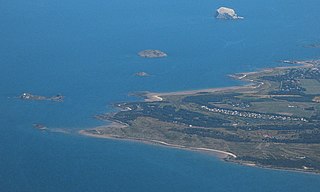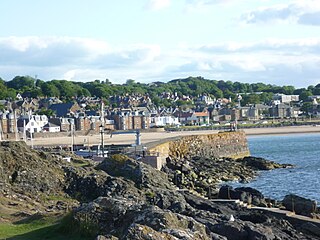
East Lothian is one of the 32 council areas of Scotland, as well as a historic county, registration county and lieutenancy area. The county was called Haddingtonshire until 1921.

The Bass Rock, or simply the Bass, is an island in the outer part of the Firth of Forth in the east of Scotland. Approximately 2 km (1 mi) offshore, and 5 km (3 mi) north-east of North Berwick, it is a steep-sided volcanic plug, 107 m (351 ft) at its highest point, and is home to a large colony of gannets. The rock is uninhabited, but historically has been settled by an early Christian hermit, and later was the site of an important castle, which after the Commonwealth period was used as a prison. The island belongs to Hew Hamilton-Dalrymple, whose family acquired it in 1706, and before to the Lauder family for almost six centuries. The Bass Rock Lighthouse was constructed on the rock in 1902, and the remains of an ancient chapel survive.

North Berwick is a seaside town and former royal burgh in East Lothian, Scotland. It is situated on the south shore of the Firth of Forth, approximately 20 miles (32 km) east-northeast of Edinburgh. North Berwick became a fashionable holiday resort in the nineteenth century because of its two sandy bays, the East Bay and the West Bay, and continues to attract holidaymakers. Golf courses at the ends of each bay are open to visitors.

John Nisbet, Lord Dirleton was a Scottish judge remembered for his prosecution of the Covenanters.

Pencaitland is a village in East Lothian, Scotland, about 12 miles south-east of Edinburgh, 5 mi (8 km) south-west of Haddington, and 1 mi (2 km) east of Ormiston.

Gullane is a town on the southern shore of the Firth of Forth in East Lothian on the east coast of Scotland. There has been a church in the village since the ninth century. The ruins of the Old Church of St. Andrew built in the twelfth century can still be seen at the western entrance to the village; the church was abandoned after a series of sandstorms made it unusable, and Dirleton Parish Church took its place.

Eyebroughy is a small, rocky islet in the Firth of Forth, 200 m off East Lothian, Scotland.

Dirleton is a village and civil parish in East Lothian, Scotland approximately 20 miles (32 km) east of Edinburgh on the A198. It contains 7,500 acres (30 km2). Dirleton lies between North Berwick (east), Gullane (west), Fenton Barns (south) and the Yellowcraigs nature reserve, Archerfield Estate and the Firth of Forth (north). Gullane parish was joined to Dirleton parish in 1612 by an Act of Parliament because "Golyn is ane decaying toun, and Dirleton is ane thriven place."

Dirleton Castle is a medieval fortress in the village of Dirleton, East Lothian, Scotland. It lies around 2 miles (3.2 km) west of North Berwick, and around 19 miles (31 km) east of Edinburgh. The oldest parts of the castle date to the 13th century, and it was abandoned by the end of the 17th century.

Kingston is a small hamlet near North Berwick in East Lothian, Scotland.
Archerfield and Archerfield Links are a country house and pair of golf courses in the parish of Dirleton, East Lothian, Scotland. An older golf course, also called Archerfield Links, occupied the area before falling into disuse after World War II.

Garvald is a village south-east of Haddington in East Lothian, Scotland. It lies on the Papana Water south of the B6370, east of Gifford. The combined parish of Garvald and Bara, borders Whittingehame to the East, Morham to the North, Yester to the West, and Lauder to the South. It is mainly an agricultural parish. The red freestone once constantly mined in this parish was well known throughout the whole country.

The Collegiate Church of St Mary the Virgin is a Church of Scotland parish church in Haddington, East Lothian, Scotland.

Colonel Robert Rickart Hepburn of Keith was Member of Parliament for Kincardineshire 1768–1774.

Clan Fenton is a Scottish clan. It does not have a clan chief recognised by the Lord Lyon King of Arms therefore the clan has no standing under Scots Law. Clan Fenton is considered an armigerous clan, meaning that it is considered to have had at one time a chief who possessed the chiefly arms, however no one at present is in possession of such arms. the arms of Fenton of that Ilk are blazoned as: Gules, a bend engrailed Argent.
Before the Act of Union 1707, the barons of the constabulary of Haddington elected commissioners to represent them in the unicameral Parliament of Scotland and in the Convention of Estates. The number of commissioners was increased from two to four in 1690.
The feudal barony of Dirleton was a feudal barony with its caput baronium originally at Castle Tarbet, Elbottle Castle and later at Dirleton Castle in East Lothian, Scotland. The de Vaux family held the barony prior it passing to the Haliburton family via the marriage of the heiress Agatha de Vaux to John de Haliburton. The barony then passed to the Ruthven family via the marriage of the heiress Janet de Haliburton to William Ruthven. After the forfeiture of the Ruthven family, the barony was granted to Thomas Erskine of Gogar in 1603. The barony was sold in 1625 to James Douglas, who sold it to James Maxwell in 1631. It was acquired by Robert Fletcher in 1658 and he later sold it to John Nisbet in 1663. Nisbet constructed Archerfield House, as his primary residence.

James Smith Richardson (1883–1970) was a Scottish architect, antiquarian and archaeologist. He was the first Inspector of Ancient Monuments for Scotland, and was responsible for a series of popular guidebooks to monuments in public care.




















